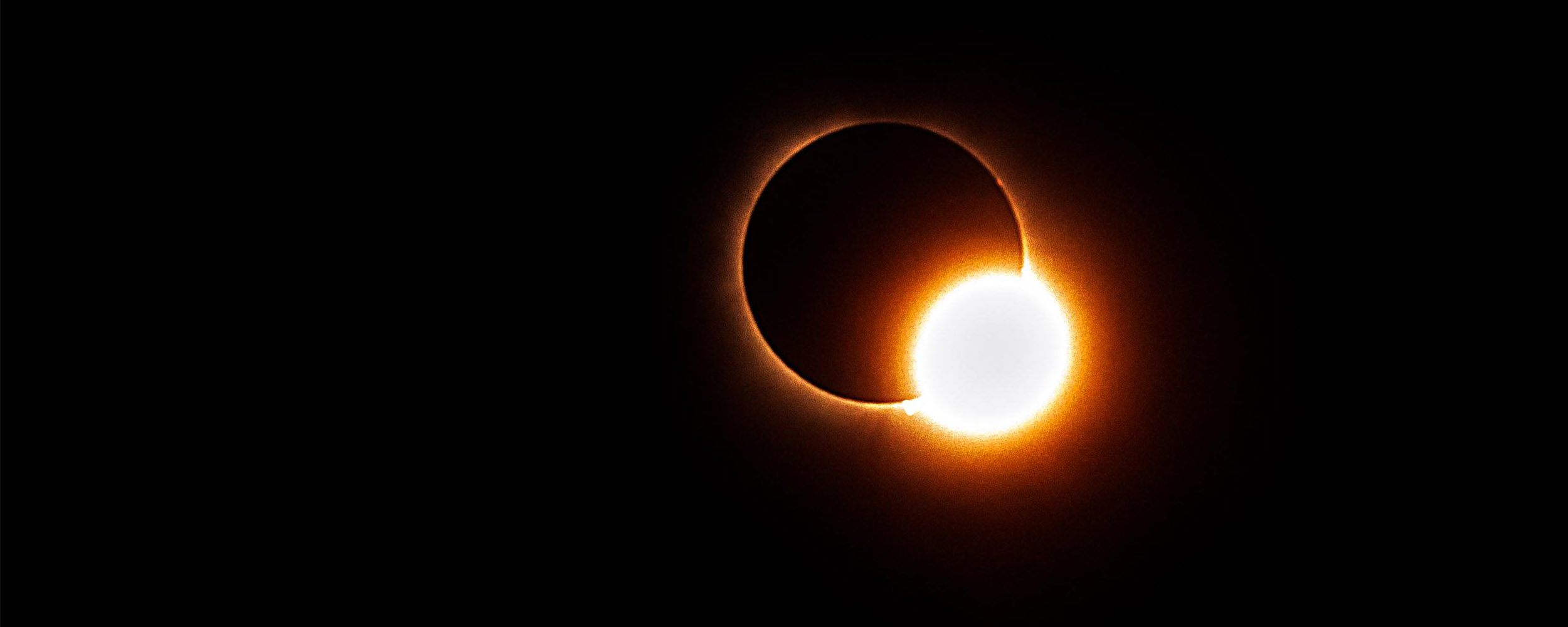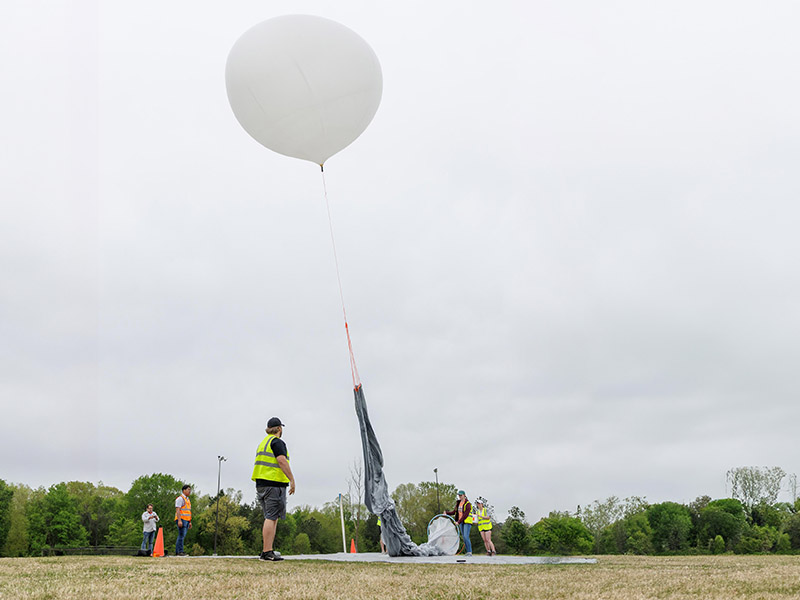
A rare opportunity: OSU researchers take advantage of solar eclipse to gather atmospheric data
Friday, November 1, 2024
Media Contact: Kristi Wheeler | Manager, CEAT Marketing and Communications | 405-744-5831 | kristi.wheeler@okstate.edu
A total solar eclipse happens somewhere on Earth about every one or two years
However, this year was special in that it was the longest total eclipse over land anywhere on the planet in a decade. Another one like it will not be seen until 2044.
Oklahoma State University’s College of Engineering, Architecture and Technology and
the Oklahoma Aerospace Institute for Research and Education used the 2024 total solar
eclipse path as a rare opportunity to improve weather forecasting.
On April 8, 16 OSU students and faculty members were joined by NASA representatives
at the Choctaw Nation Community Center in Broken Bow, Oklahoma, to conduct research
as part of the NASA National Eclipse Balloon Program, which started at 12:25 p.m.,
with totality being from 1:45 -1:50 p.m., and ended at 3 p.m.
Dr. Jamey Jacob, regents professor in the School of Mechanical and Aerospace Engineering
and OAIRE executive director, likened the eclipse’s effect to a pebble in a pond.
“Just like a pebble causes waves in the water, the eclipse causes gravity waves in
its wake as it moves across the Earth, and we want to measure those disturbances,”
he said.
“These waves are essential for transporting energy in the atmosphere. They’re good
at mixing the air and act as conveyor belts to help move moisture from one location
to another, just like waves in the ocean.”
Jacob said the goal is to take the atmospheric readings from such a rare but known
event and use them to provide general improvements to numerical weather prediction
models.
“The atmosphere is so complex to model — it’s just a very complicated phenomena,”
he said. “The eclipse provides a way to verify existing models using a known condition.”

OSU was one of 53 teams across the U.S. in the NASA program, with OSU serving as an
atmospheric science pod lead.
OSU was responsible for organizing and supporting other teams leading up to the eclipse
and bringing their data together after the event. Teams were spread out between Texas,
Oklahoma and Arkansas.
The OSU team also had a distinction from others compiling data; Dr. Brian Elbing,
a professor of mechanical and aerospace engineering and renowned OSU tornado researcher,
incorporated infrasonic arrays into the data collection arsenal to better understand
how those systems work for tornado detection.
OAIRE also took drones to serve as a repeatable system taking the same measurements.
Jacob said someday, the balloons that carry the instruments will be replaced by drone
fleets.
Zach Yap, a research and development engineer with OAIRE, has conducted research with
OSU for years, including his years as a mechanical and aerospace engineering undergraduate
and graduate student.
“This was a wonderful opportunity to see what happens when you essentially turn off
the sun and have a rapid onset of darkness,” he said. “An eclipse is an interesting
and unique way of generating atmospheric gravity waves. They happen between different
layers in the atmosphere, and the waves are good movers of energy for storms and other
things. If we can better understand how these waves propagate through the atmosphere,
we can better — on a continental scale — forecast weather systems.”
Outreach and engagement
In addition to OSU leading several other universities, OSU researchers had the opportunity
to be a resource for students at Gordon Cooper Technology Center in Shawnee as well
as Okmulgee High School.
“Through the Nationwide Eclipse Ballooning Project (NEBP) and OSU, we can give them
the opportunity and resources to learn from these opportunities,” Yap said. “By doing
this, we can share this knowledge and inspire them to pursue a STEM career.”
Jacob said the effort included the whole range of student involvement.
“On the science side, we had high school, undergraduate and graduate students working
together, and while at the eclipse we used this opportunity for science outreach for
younger kids and to our tribal partners,” he said. “The eclipse itself is a cosmic
marvel that inspires awe in all who see it. What better way to reach the next generation
of scientists and engineers?”
Ongoing research
Kate Spillman, a mechanical and aerospace engineering graduate student working for
Elbing — along with three other team members — was tasked with redesigning the payload
that attaches to a solar balloon to record atmospheric changes for the day of the
eclipse.
Solar balloons use the sun’s radiation to float in the lower stratosphere. They are
launched early in the morning and naturally descend when the sun sets because there
is no longer enough radiation to support them.
The team’s main goal was to reduce the weight of the payload, which would let them
use a smaller, more reliable balloon. It was also tasked with developing a design
to attach a solar radiation sensor, which records the solar radiation and is located
on top of the payload.

During the total eclipse, the team launched two solar balloons.
“We used large helium weather balloons to tow the solar balloons up to wherever the
weather balloons burst at, which ended up being 70,000-80,000 feet,” Spillman said.
“What the solar balloon is supposed to do, since it’s towed up there, is it should
come down a little bit, inflate and then reach its float altitude, which is around
60,000-70,000 feet.”
The first balloon launched at 1500 UTC and was able to reach float altitude after
the helium balloon burst. However, the balloon ripped at 1846 UTC, just three minutes
before eclipse totality. The second balloon launched at 1620 UTC and failed before
the helium balloon burst, which they think was a result of the manufacturer changing
the chemical compound of the tape that is used to construct the balloon.
Solar radiation decreases during a solar eclipse. One of the things that the research
team was looking at during the solar eclipse was to see how much of a delay there
was between the time the solar radiation started to decrease and the time when the
balloon’s altitude began to decrease.
“When an eclipse happens, you would expect to see the balloon start to come down,
but what’s interesting is we could almost perfectly see the balloon dropping in altitude
as soon as part of the sun was blocked,” Elbing said. “We immediately saw a change
in its performance.”
Before the team launches a balloon, they will utilize a Python script to enter the
weight of the payload, where they are going to launch from, the altitude, and the
time of day. The Python script can run trajectories about where the balloon is and
where it’s expected to go, which benefits the team.
“This is very beneficial for us because these balloons can go very far distances,”
Spillman said. “We’ve had some that run all the way into the Atlantic Ocean. The trajectories
can tell us if we should launch that day or not and how far the balloon will go. Once
the balloon passes a certain latitude or longitude, we can set up a geofence and,
if needed, cut the payload down and we can still retrieve the data while the balloon
will fly away.”
During the total eclipse, the research team wanted to see if their radiation model
was accurate. Instead of seeing a gradual exponential curve, they saw a sharp drop.
Because of this, the team concluded that the model didn’t account for the length of
time it would take for the air in the balloon to cool down. This preliminary analysis
shows they may be able to modify the code, making it more accurate.
“If we design the balloon to fly at a certain altitude in the atmosphere, you need
to know the percentage of the radiation that is actually absorbed in the balloon,
so you have to know the temperature inside, which sets how much buoyancy lift you
have,” Elbing said. “There are models that were estimated, but most of the time, radiation
levels aren’t measured because they cannot be controlled. However, the total eclipse
offered a unique opportunity to see the correlation between how the balloon reacts
to increased and decreased solar radiation.”
Elbing will continue his research in infrasound using these balloons.
“One of the things Kate and I want to do is use these balloons to fly over storms
because infrasound is very directionally dependent when you’re at the ground measuring
it, but it’s a lot less sensitive at altitude,” Elbing said. “We’ve flown several
of our sensors on balloons, we’ve overflown some storms, but we want to start to measure
from above the storms instead of below the storm.”
Future research beyond Earth
“At some point, NASA wants to launch some type of balloon-based ariel platform on
Venus to learn about its interior structure, and learning about that can tell us about
our planet’s evolution as well,” Spillman said. “One of the avenues is to use a type
of zero-pressure balloon, and OSU has been an instrumental part in developing and
continuing that research. I’m going to be looking at mitigating wind noise on the
payloads.”
On Venus, the winds are very high. The goal is to launch in the middle atmosphere,
where the weather conditions are much less severe and the winds are lower than the
exterior, but either way, there will be wind noise on the payload. Reducing that wind
noise by a physical setup rather than modifying the code will decrease the risk of
losing their signals.
Still, there is much to learn about Venus and the research being done at OSU through
balloon launches is a big part of what researchers worldwide are learning.
Story by: Kristi Wheeler and Shannon Rigsby | IMPACT Magazine
Photos: Gary Lawson
